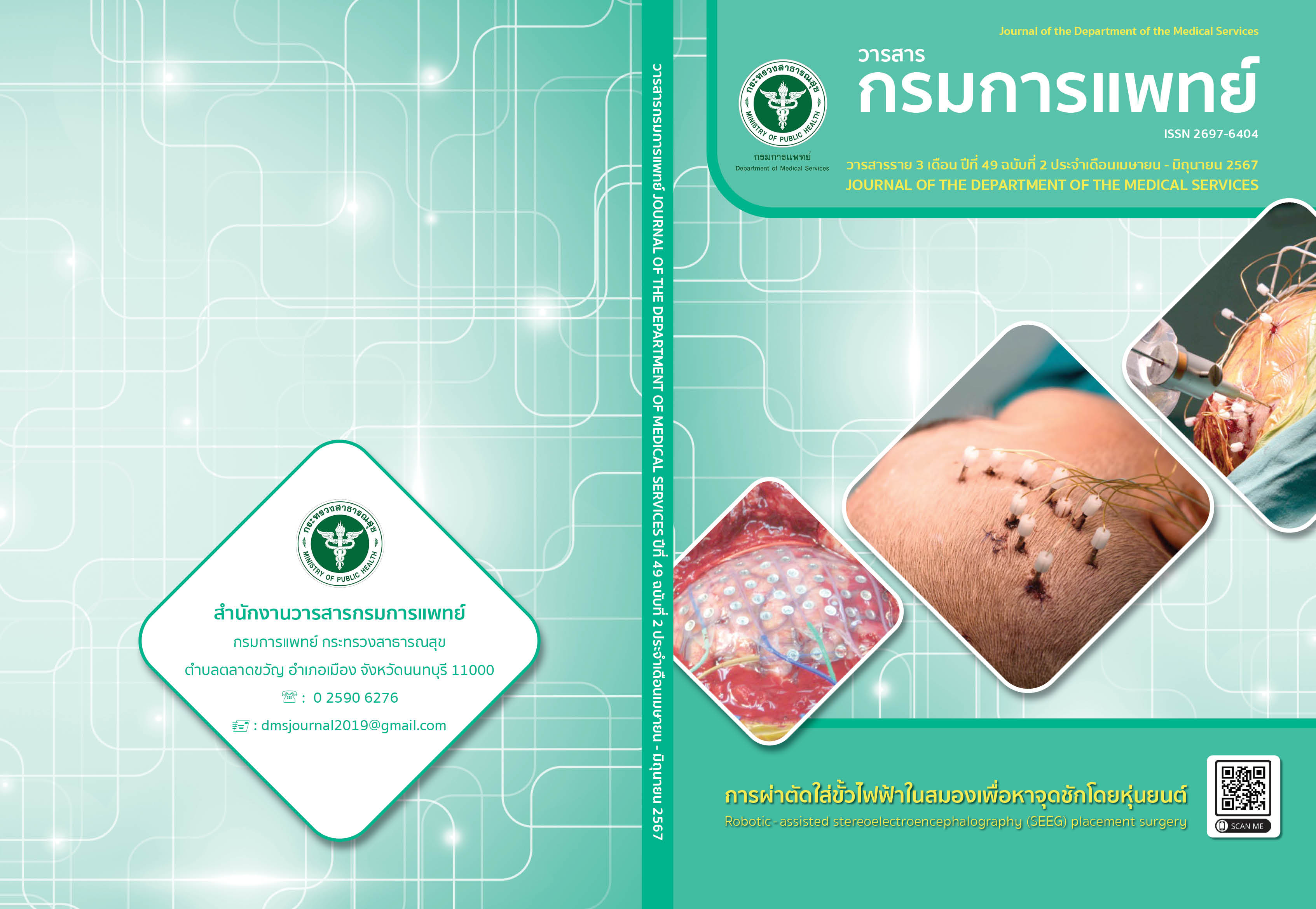ความชุกของภาวะความผิดปกติทางกายภาพของกระดูกสันหลังส่วนกระเบนเหน็บของผู้ป่วยในโรงพยาบาลราชวิถี: การศึกษาย้อนหลัง
คำสำคัญ:
ความผิดปกติของกระดูกเชิงกราน, ประชากรไทย, การยึดสกรูผ่านผิวหนังบทคัดย่อ
ภูมิหลัง: ความผิดปกติของกระดูกเชิงกราน มีกายวิภาคผิดปกติของ sacrum ตอนบน dysmorphic sacra มีทางเดินกระดูกส่วนบนที่แคบและเป็นมุมซึ่งเพิ่มความเสี่ยงของการเจาะเยื่อหุ้มสมองในระหว่างการใส่สกรู iliosacral และสกรู transacral จากการรับรู้ไม่มีข้อมูลสถิติของโรคนี้ ในประเทศไทย ผู้วิจัยต้องการรวบรวมข้อมูลทางสถิติสำหรับผู้ป่วยกลุ่มนี้ในประเทศไทย วัตถุประสงค์: เพื่อศึกษาความชุกของภาวะผิดปกติของเชิงกรานของผู้ป่วยในโรงพยาบาลราชวิถี วิธีการ: เก็บข้อมูลจากฐานข้อมูลของโรงพยาบาลราชวิถีในรอบ 5 ปีที่ผ่านมาตั้งแต่วันที่ 1 มกราคม 2016 - 31 ธันวาคม 2020 ได้รับการวิเคราะห์เพื่อหาความชุกของ sacral dysmorphia และทางเดินที่ปลอดภัยของการยึดสกรู ผ่านผิวหนังที่ sacrum ผล: รวบรวมข้อมูลผู้ป่วยทั้งหมด 594 ราย ความผิดปกติของกระดูกเชิงกราน พบใน 136 ราย คิดเป็น 23% พบว่าเพศไม่ส่งผลต่อความชุกของโรค แต่ส่งผลต่อขนาดของเชิงกราน โดยเพศชายจะมีขนาดใหญ่กว่าอย่างเห็นได้ชัด group sacral dysmorphia มี 94.1% ไม่สามารถใส่สกรู transacral ที่ตำแหน่ง S1 ได้โดยมีความกว้างและความสูงเฉลี่ย 15.46, 17.00 มม. ตามลำดับ ส่วนที่ตำแหน่ง S2 สามารถใส่ได้ทั้งสกรู iliosacral และ transacral ทุกขนาด (6.5,7.0และ7.3มม.)โดยมีความกว้างและความสูงโดยเฉลี่ย 13.98,17.84มม.ตามลำดับ สรุป:ผู้วิจัยแนะนำให้ใช้ตำแหน่ง S2 แทนตำแหน่ง S1 ในการยึดสกรูผ่านผิวหนังในผู้ที่เป็นโรคความผิดปกติของกระดูกเชิงกราน โดยมีข้อดี คือ ปลอดภัย ภาวะแทรกซ้อนต่ำ ผ่าตัดง่าย แข็งแรง
เอกสารอ้างอิง
Miller AN, Routt ML Jr. Variations in sacral morphology and implications for iliosacral screw fixation. J Am Acad Orthop Surg 2012;20(1):8 - 16.
Hasenboehler EA, Stahel PF, Williams A, Smith WR, Newman JT, Symonds DL, et al. Prevalence of sacral dysmorphia in a prospective trauma population: Implications for a “safe” surgical corridor for sacro - iliac screw placement. Patient Saf Surg 2011;5(1):8.
Routt ML Jr, Simonian PT, Agnew SG, Mann FA. Radiographic recognition of the sacral alar slope for optimal placement of iliosacral screws: a cadaveric and clinical study. J Orthop Trauma 1996;10(3):171 - 7.
Kaiser SP, Gardner MJ, Liu J, Routt ML Jr, Morshed S. Anatomic determinants of sacral dysmorphism and implications for safe iliosacral screw placement. J Bone Joint Surg Am 2014;96(14):e120.
Gardner MJ, Morshed S, Nork SE, Ricci WM, Chip Routt ML Jr. Quantification of the upper and second sacral segment safe zones in normal and dysmorphic sacra. J Orthop Trauma 2010;24(10):622 - 9.
Conflitti JM, Graves ML, Chip Routt ML Jr. Radiographic quantification and analysis of dysmorphic upper sacral osseous anatomy and associated iliosacral screw insertions. J Orthop Trauma 2010;24(10):630 - 6.
Kim JJ, Jung CY, Eastman JG, Oh HK. Measurement of optimal insertion angle for iliosacral screw fixation using three - dimensional computed tomography scans. Clin Orthop Surg 2016;8(2):133–9.
Weigelt L, Laux CJ, Slankamenac K, Ngyuen TDL, Osterhoff G, Werner CML. Sacral dysmorphia and its implication on the size of the sacroiliac joint surface. Clin Spine Surg 2019;32(3): E140-4.
Trikha V, Gaba S, Kumar A, Mittal S, Kumar A. Safe corridor for iliosacral and trans - sacral screw placement in Indian population: a preliminary CT based anatomical study. J Clin Orthop Trauma 2019;10(2):427 - 31.
Manaf AR, Qoreishi M, Maleky AF, Zandi R, Elahi M, Dehkhoda F. Determination of anatomical sacral dysmorphism criteria based on CT scan findings for Iliosacral screw fixation in a sample of Iranian Population without Pelvic Ring Fracture. Trauma Monthly 2020;25(4):153 - 59.
Wayne WD. Biostatistics: A foundation of analysis in the health sciences. 6th ed. New York: John Wiley and Sons; 1995.
ดาวน์โหลด
เผยแพร่แล้ว
รูปแบบการอ้างอิง
ฉบับ
ประเภทบทความ
สัญญาอนุญาต
ลิขสิทธิ์ (c) 2024 กรมการแพทย์ กระทรวงสาธารณสุข

อนุญาตภายใต้เงื่อนไข Creative Commons Attribution-NonCommercial-NoDerivatives 4.0 International License.
บทความที่ได้รับการตีพิมพ์เป็นลิขสิทธิ์ของกรมการแพทย์ กระทรวงสาธารณสุข
ข้อความและข้อคิดเห็นต่างๆ เป็นของผู้เขียนบทความ ไม่ใช่ความเห็นของกองบรรณาธิการหรือของวารสารกรมการแพทย์



